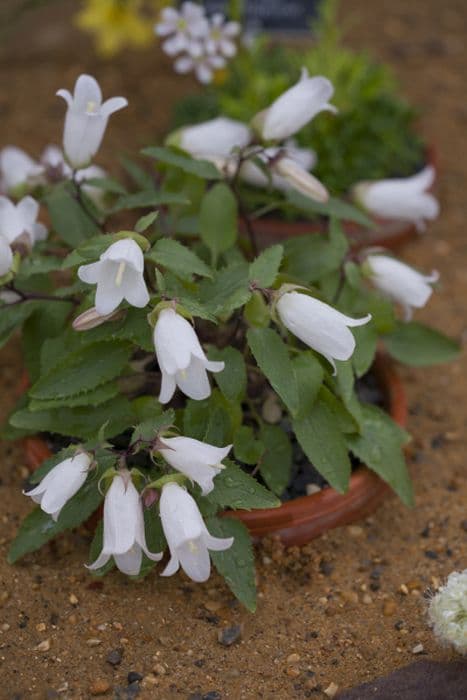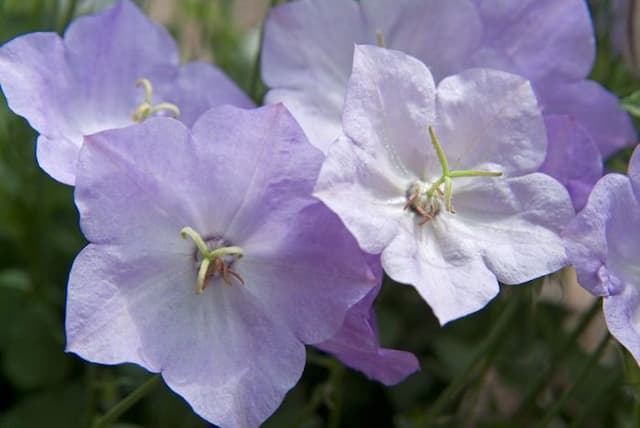Edging Lobelia Lobelia erinus 'Regatta Sky Blue'

ABOUT
Lobelia erinus 'Regatta Sky Blue' is commonly known as the trailing lobelia. This plant is adorned with masses of small, delicate flowers. The flowers are a striking sky blue color, each typically featuring a white eye at the center, giving them a distinctive and captivating appearance. The petals exhibit a slightly frilled edge, which adds to their ornamental appeal. The foliage of trailing lobelia is made up of narrow, green leaves, which provide a lush backdrop for the floral display. Due to its trailing habit, the plant is known to cascade gracefully, which makes it an ideal choice for hanging baskets, window boxes, or as a ground cover. Throughout its blooming season, the trailing lobelia presents a vibrant display that can add a splash of cool-toned color to any gardening space. The contrast between the vivid blue blossoms and the fresh green leaves culminates in a refreshing palette that enhances any area it adorns. Its continuous flowering ability ensures that it remains a highlight in the garden for an extended duration.
About this plant
 Names
NamesFamily
Campanulaceae
Synonyms
Edging Lobelia, Garden Lobelia, Trailing Lobelia, Regatta Sky Blue Lobelia
Common names
Lobelia erinus 'Regatta Sky Blue'.
 Toxicity
ToxicityTo humans
Lobelia is generally considered to have a low level of toxicity to humans. However, ingesting significant quantities of the plant can lead to symptoms such as nausea, vomiting, diarrhea, cough, dizziness, excessive salivation, and weakness. In more severe cases, it could potentially lead to heart problems or convulsions. It's important to keep in mind, these symptoms are based on substantial ingestion, and the plant is not typically considered dangerous under normal handling and occasional contact.
To pets
Lobelia is also considered to have a low level of toxicity to pets such as dogs and cats. If a pet ingests a large amount of the plant, it might experience symptoms including vomiting, diarrhea, drooling, and lethargy. In severe cases, more serious symptoms such as difficulty breathing, rapid heart rate, or muscle weakness could develop. If any signs of poisoning are observed after a pet ingests any part of lobelia, it is advisable to contact a veterinarian.
 Characteristics
CharacteristicsLife cycle
Annuals
Foliage type
Evergreen
Color of leaves
Green
Flower color
Sky Blue
Height
0.5 feet (15 cm)
Spread
1 feet (30 cm)
Plant type
Herb
Hardiness zones
10
Native area
South Africa
Benefits
 General Benefits
General Benefits- Aesthetic Appeal: The 'Regatta Sky Blue' Lobelia, commonly known as trailing lobelia, features vibrant sky-blue flowers that enhance the visual appeal of gardens and landscapes.
- Compact Growth: Ideal for small spaces due to its compact and mounding growth habit.
- Container Gardening: Well-suited for container or hanging basket culture, adding versatility in garden design.
- Seasonal Color: Provides a long blooming season, typically from spring to fall, offering continual color in the garden landscape.
- Attracts Pollinators: Flowers of the trailing lobelia attract bees and butterflies, promoting biodiversity.
- Low Maintenance: Requires minimal care once established, making it suitable for novice gardeners.
- Border Planting: Its mounded form makes it a perfect choice for borders or edging along garden beds.
- Companion Planting: Pairs well with other plants in mixed plantings, providing a harmonious blend of colors and textures.
- Cool Season Tolerance: Exhibits good tolerance to cooler temperatures in spring and fall compared to some other annuals.
- Drought Tolerance: Once established, has a certain degree of drought tolerance, although it prefers consistent moisture.
 Medical Properties
Medical PropertiesThis plant is not used for medical purposes.
 Air-purifying Qualities
Air-purifying QualitiesThis plant is not specifically known for air purifying qualities.
 Other Uses
Other Uses- Lobelia as a natural dye: The flowers of Lobelia can be used to create a gentle blue dye for fabrics or paper crafts.
- Photography prop: The striking blue flowers can be used as a photogenic prop in macro photography or botanical photo shoots.
- Garden borders: Planting Lobelia along the edges of garden pathways creates a vivid border that accentuates the landscape design.
- Fairy gardens: Due to their small size and delicate flowers, Lobelia plants are perfect for creating whimsical fairy garden scenes.
- Educational tool: Lobelia can be used in schools to teach students about plant growth, pollination, and the life cycle of flowers.
- Art inspiration: The unique blue of the Lobelia blooms can inspire artists for paintings, textile designs, or even makeup artistry.
- Lobelia seed crafts: The small seeds of Lobelia can be collected and used in homemade jewelry or mosaics.
- Pressed flower craft: Lobelia flowers can be pressed and used for creating bookmarks, greeting cards, or framed botanical art.
- Culinary decoration: While not for consumption, the flowers can garnish dishes in food photography or at formal events (must ensure they are removed before eating).
- Plant pairing education: Lobelia can be used to teach about companion planting in gardens, exemplifying which plants grow well together for mutual benefit.
Interesting Facts
 Feng Shui
Feng ShuiLobelia is not used in Feng Shui practice.
 Zodiac Sign Compitability
Zodiac Sign CompitabilityLobelia is not used in astrology practice.
 Plant Symbolism
Plant Symbolism- Devotion & Loyalty: Lobelia often symbolizes devotion due to its dependable flowering and steadfast nature.
- Attraction: Its vibrant blue flowers are thought to attract love and positive energy, much like the striking color attracts the eye.
- Communication: The bright color of the 'Regatta Sky Blue' variety can be associated with clear skies and openness, suggesting effective communication and expression of ideas.
 Water
WaterThe trailing lobelia should be watered regularly, maintaining moist but not waterlogged soil. It is important to water deeply, allowing water to penetrate several inches into the soil, which could approximately be half a gallon for an outdoor plant every week, depending on weather conditions. During hot and dry periods, increase watering frequency to every few days, and in cooler, rainy spells, reduce the watering to prevent over-saturation. Always check the top inch of the soil before watering; if it's dry, it's time to water.
 Light
LightTrailing lobelia thrives in a location that provides full sun to partial shade, with a preference for cool climates. The optimal spot would allow for morning sunlight and afternoon shade, especially in hotter regions, to protect the flowers from midday heat. Ensure the plant has access to bright indirect light if grown indoors, simulating its preferred outdoor conditions.
 Temperature
TemperatureTrailing lobelia favors cooler conditions and is typically grown as an annual in most climates. It can survive minimum temperatures down to about 40 degrees Fahrenheit but thrives best when daytime temperatures are between 60 and 70 degrees Fahrenheit. It can handle maximum temperatures up to about 85 degrees Fahrenheit but may require some shade to protect from intense heat.
 Pruning
PruningTrailing lobelia should be pruned to promote bushier growth and to encourage more blooms. Lightly pinch back the stem tips every few weeks during the growing season. The best time to prune is after a flush of blooms starts to fade, which will help stimulate new growth and additional flowering.
 Cleaning
CleaningAs needed
 Soil
SoilThe best soil mix for Lobelia, commonly known as edging lobelia or garden lobelia, should be light, well-draining, and rich in organic matter with a pH range of 5.5 to 6.5. A mixture of peat, compost, and perlite or vermiculite can provide the right balance of nutrients, moisture, and aeration.
 Repotting
RepottingEdging lobelia should be repotted every year to replenish the soil, ideally in the spring before new growth begins. They don't typically outgrow their pots quickly due to their compact size, but annual repotting ensures they have fresh soil for optimal health.
 Humidity & Misting
Humidity & MistingGarden lobelia thrives best in moderate to high humidity conditions, generally preferring a humidity level around 40-70%. It can tolerate lower humidity, but consistently dry air may cause stress to the plant, so it's important to maintain these levels for optimal growth.
 Suitable locations
Suitable locationsIndoor
Place in bright, indirect light and keep soil moist for indoor Lobelias.
Outdoor
Plant in partial sun, ensure moist, fertile soil for outdoor Lobelias.
Hardiness zone
10-11 USDA
 Life cycle
Life cycleThe life cycle of Lobelia erinus 'Regatta Sky Blue', commonly known as the edging lobelia or garden lobelia, begins with seed germination, which occurs in warmth with high humidity, usually after 15 to 20 days of sowing. Following germination, seedlings develop into young plants with characteristic narrow, green leaves and begin to form a small rosette. As the plant matures, it enters a vegetative stage, producing more leaves and branching out, preparing for flowering. The flowering stage occurs when the plant produces numerous small, trumpet-shaped, sky blue flowers, typically from late spring through to the first frost in the fall. After pollination, the plant sets seed, completing its reproductive stage; these seeds can be collected or left to self-sow. Finally, Lobelia erinus is an annual or tender perennial, and in cooler climates, it completes its life cycle within one growing season, dying after seed production unless protected from frost or cold temperatures.
 Propogation
PropogationPropogation time
Spring to Summer
The Lobelia erinus 'Regatta Sky Blue', more commonly known as edging lobelia or garden lobelia, is most frequently propagated by seed. The ideal time for sowing lobelia seeds is late winter to early spring, this timing allows for the seedlings to mature before they are transplanted after the threat of frost has passed. The seeds are very tiny and need light to germinate, so they should be sprinkled onto the surface of a well-draining seed starting mix and gently pressed in, without being covered by soil. Then, the container is typically placed under grow lights or in a brightly lit area, maintaining a temperature of about 70 to 75 degrees Fahrenheit (21 to 24 degrees Celsius). Keeping the soil moist but not waterlogged is crucial, as the seeds can easily rot with excess water. Seedlings usually emerge within two to three weeks, and once they reach a height of 2 to 3 inches (5 to 7.6 centimeters), they can be thinned out or transplanted to individual pots before being moved to their final garden location.









